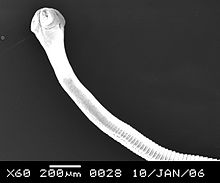Raillietina
| Raillietina | |
|---|---|
 |
|
| Raillietina tetragona | |
| Scientific classification | |
| Kingdom: | Animalia |
| Phylum: | Platyhelminthes |
| Class: | Cestoda |
| Order: | Cyclophyllidea |
| Family: | Davaineidae |
| Genus: |
Raillietina Fuhrman, 1920 |
| Diversity | |
| 37 species | |
Raillietina is a genus of tapeworms that includes helminth parasites of vertebrates, mostly of birds. The genus was named in 1920 in honour of a French veterinarian and helminthologist, Louis-Joseph Alcide Railliet. Of the 37 species recorded under the genus,Raillietina demerariensis, R. asiatica, and R. formsana are the only species reported from humans, while the rest are found in birds. R. echinobothrida, R. tetragona, and R. cesticillus are the most important species in terms of prevalence and pathogenicity among wild and domestic birds.
Some important species include:
The body of an adult Raillietina is a typical tapeworm structure, composed of a series of ribbon-like body segments, gradually enlarging from the anterior end towards the posterior. It is whitish in colour, highly elongated, dorso-ventrally flat, and entirely covered with a tegument. The entire body is divisible into 3 parts, namely the head region called scolex, followed by an unsegmented neck or growth region, and then by highly segmented body proper called strobila. The scolex is a bulbous knob-like structure bearing suckers and a rostellum, which are the organs of attachment to the host. A defining structure from those of other tapeworms is a single prominent rostellum surrounded by four suckers. Further, an important diagnostic character among the different species of the genus is the number and arrangement of hooks and spines on the scolex. The suckers are poorly developed, and completely devoid of special devices or spines. The scolex measures ~134 μ in diameter, and the hooks are 7-10 μ in length. Individual segments in the strobila are called 'proglottids' and are entirely covered with hair-like microtriches. These microtriches are the absorptive structures for feeding, and there are no digestive organs. As all other cestodes, they are hermaphrodite. A set of both male and female reproductive systems is present in each proglottid.
...
Wikipedia
